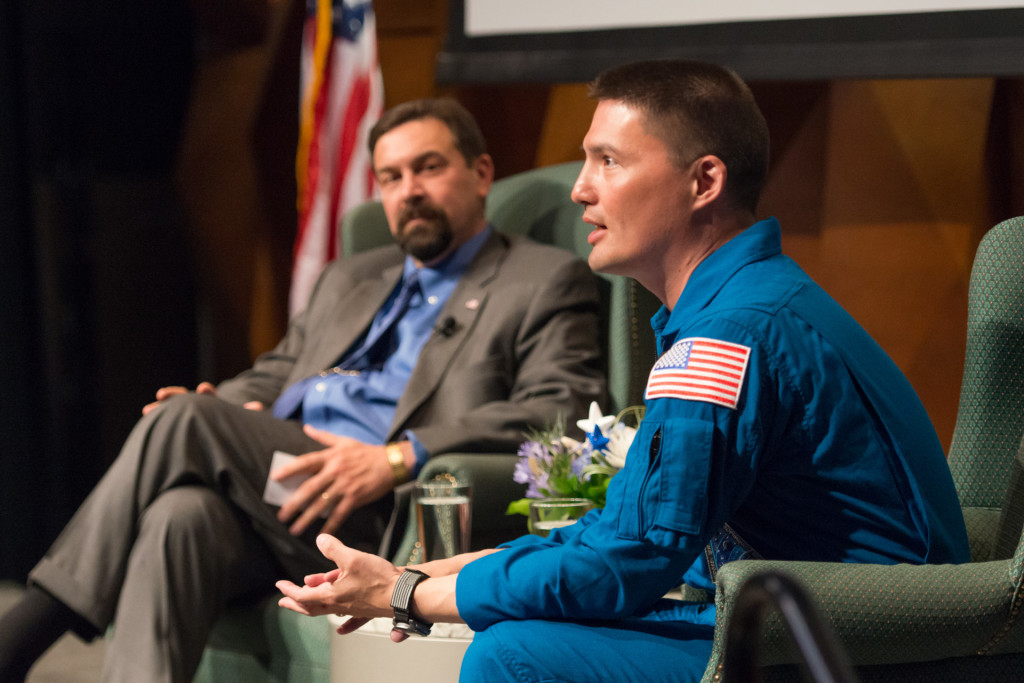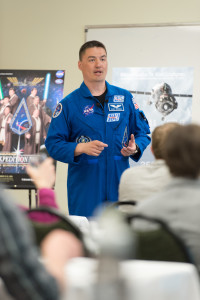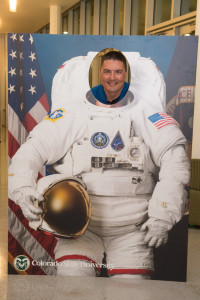
NASA Astronaut and CSU Alumnus Kjell Lindgren talks to the Colorado State University community. CSU President Tony Frank moderated a discussion with Lindgren on campus. Photo: CSU Photography
That panic when you lose your car keys? Dr. Kjell Lindgren felt it while flying on the International Space Station.
Only he misplaced his personal dosimeter, the device that monitors an astronaut’s exposure to galactic cosmic rays. Understanding the effects of space radiation on astronaut health is a core focus for NASA during long-term space flights, which form a run-up to Mars.
So losing that little key? Houston might see it as a problem.
“I was imagining having to make that call to Mission Control,” Lindgren recalled with a laugh, while chatting with students and researchers at Colorado State University. “Fortunately it was in my pocket.”

Lindgren recently completed his rookie flight on the International Space Station – a mission that spanned six months living and working in microgravity – and he returned Monday and Tuesday to Colorado State, where he earned a master’s degree in cardiovascular physiology before launching a career with NASA.
On Tuesday evening, he shared highlights of his journey with an overflow crowd of about 500 people at the Lory Student Center Theatre.
“It’s great to be back here,” said Lindgren, wearing his blue flight suit. “My journey into space really started here, and I got to personally experience all the things I had studied. So this is really coming full circle.”
While logging nearly 60 million miles on the orbiting national laboratory, Lindgren conducted experiments for 240 scientific research projects, including a notable investigation at CSU.
Here, Susan Bailey, a cancer molecular biologist, is examining the effects of space radiation on DNA end-caps – called telomeres – within the cells of astronauts. Telomeres are biological markers of aging and could help determine the risk of developing age-related diseases, such as cancer, when people are exposed to radiation during long-term space flight.
Her work is part of the famous NASA Twins Study involving astronaut Scott Kelly, who just completed a yearlong mission in space, and his earthbound twin brother, Mark, who serves as a scientific control. Kelly was mission commander and space-flight mentor for Lindgren.
“The telomere study would come up on our daily work schedule, and we would do the blood draws,” Lindgren said during a stop in Bailey’s lab, which abounds with vials of cells and blood drawn from astronauts and control subjects. “To be here where it’s analyzed is pretty cool.”

Students and researchers were star-struck by Lindgren, a study subject who likewise served as the hands, eyes and ears of scientists who examine critical space-based questions from the ground.
“With this science, it’s easy to get tunnel vision: Have the telomeres shortened? Have they lengthened? Being able to meet Kjell reinforces what’s really important to us, and that’s astronaut safety – especially in deep space, which will be required for travel to Mars,” said Miles McKenna, a graduate student working in Bailey’s lab.
Thrilling for other students was hearing about Lindgren’s path to space: from a bachelor’s degree in biology to studies of cardiovascular physiology, and on to a medical degree with specialties in emergency and aerospace medicine.
His thesis assessed use of inflatable thigh cuffs, called “Braslets,” to counter the flood of blood to an astronaut’s upper body and brain during weightlessness. This fluid dynamic is among the ravages of microgravity on the human body.
“I got my own pair of Braslets for space flight,” Lindgren said.
His space walks, for maintenance and repair work on the exterior of the International Space Station, were “the most mentally and physically challenging thing I’ve ever done,” the astronaut said.
He noted that crews spend about 40 percent of their time taking care of the space station. It makes sense: “It’s all there is protecting us from the cold void of space.”
When Clark Cranfill, an undergraduate in biomedical sciences, asked Lindgren how long-term space flight has affected his philosophy, his outlook on life, the astronaut answered with a metaphor comparing the space station to planet Earth.
“I was hoping being in space would have a profound effect on me, and the thing that really changes you is seeing the Earth from that perspective with your own eyes,” Lindgren said.
“To see the entire disk of the Earth below you, and all the changes man has had, it makes you realize that Earth is a big blue spaceship floating in the cold void of space,” he continued. “It is a finite and fragile resource, and we need to take care of it.”
Media Assets
Photo
Click photos in story to enlarge. Credit photographer named in photo captions above
Video
Lindgren visit raw interviews, footage